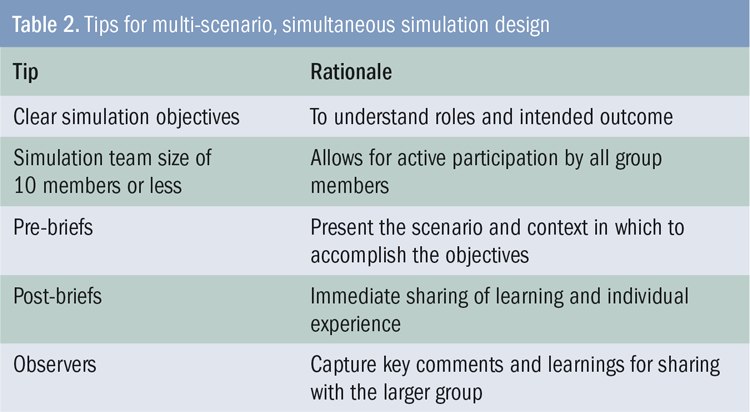Fundamentally Human: Learning By Design
Lessons learned and looking ahead
This fall, the team is tackling serious illness conversations and palliative care with a careful planning approach. Brainstorming around simulation design began immediately around the key question: “What are the participant objectives for the simulation?” Good design has to begin there, as well as being cognizant of the backgrounds of all attendees (Table 2). The team heard through consistent evaluation feedback that small simulation groups are preferred, as they allow for more active participation by all attendees.
Simulation pre-briefs are crucial to ensure participants have a clear understanding of their roles and objectives prior to beginning the simulation activity. A debrief immediately following the activity allows those who participated to give and receive immediate observation and feedback regarding what was learned.
Observers were placed in the simulation sessions in 2016. Their role was to listen and take notes during the simulations, capturing key comments and learnings to share during the larger debrief sessions. It was much easier to pull that information together through an observer’s watchful eye for meaningful discussion.
Alternatively, for organizations that do not have resources for a simulation center, in-situ simulation is a great option. These simulations are carried out in the actual clinical areas of care, and with strong objectives, pre-briefs, and debriefs, can also achieve significant outcomes without substantial investment.
Being fundamentally human means the MHQA has learned from many early mistakes, but it has continued to improve. With each year, the activity has expanded; with every expansion, it attracts more attendees, brings in more complex simulations, and adds diverse topics. Paul Nitze (n.d.) once said, “One of the most dangerous forms of human error is forgetting what one is trying to achieve.” Keeping in mind the broad goals for the formation of the MHQA—improving healthcare safety and quality across populations through research, education, and simulation—the MHQA planning team has a bright beacon to keep them on track.
Authors’ note: The authors wish to thank Lindsay Price, MHS, PT, CLSSGB, and Mary McKee, MA, MT, both of Memorial Health System, for contributing to the development of this article.
Carol Hafley, MHA, RN, FACHE, CPPS, is the system director of the Quality Alliance Patient Safety Organization, a component of MHQA. She is a Fellow of the American College of Healthcare Executives and a Certified Professional in Patient Safety, as well as a Certified Lean Six Sigma Green Belt. Contact info: www.qapso.org; www.mhqa.org; hafley.carol@mhsil.com.
Geri Kirkbride, RN, PhD, CNEP, CPPS, is the patient safety nurse coordinator for Memorial Health System, and a patient safety consultant for MHQA. She is a Certified Professional in Patient Safety and is Certified in Executive Nursing Practice. Contact info: kirkbride.geri@mhsil.com.
Jim Wilkerson, MS, CLSSMBB, LCPC, is the System Director of Operations Improvement with Memorial Health System and a Lean Six Sigma professional consultant for the MHQA. Wilkerson is a Certified Lean Six Sigma Master Black Belt and a Licensed Clinical Professional Counselor. He is a member of the American Society for Quality and the Society for Simulation in Healthcare. Contact info: wilkerson.jim@mhsil.com.

